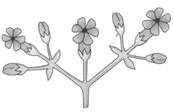EASY
Earn 100
Classify the inflorescence based on their position.
Important Questions on Morphology in Flowering Plants
MEDIUM
| List - I | List - II | ||
| (a) | Flowers appear to have arisen from the same point of peduncle | (i) | Corymb |
| (b) | The sessile flowers are arranged on peduncle in acropetal manner | (ii) | Umbel |
| (c) | The sessile unisexual and neuter flowers arranged in acropetal succession protected by a modified bract | (iii) | Spike |
| (d) | Unisexual and/or bisexual sessile flowers develop centripetally on a condensed peduncle | (iv) | Capitulum |
| (v) | Spadix |
The correct answer is
EASY
EASY
EASY
| List- | List- | ||
| (A) | Musa, Cocos, Colocasia | (I) |
Corymb |
| (B) | Crotalaria, Mangifera | (II) |
Spike |
| (C) | Cassia, Cauliflower | (III) |
Umbel |
| (D) | Achyranthes, Grasses | (IV) | Spadix |
| (V) | Raceme |
The correct match is:
HARD
MEDIUM
A) In cyathium bisexual, achlymadeous flowers are present.
B) If calyx and corrella are not distinct they are called perianth.
C) In nut, pericarp is stony.
D) The thin membranous structure in the axil of leaf is called bractiole.
EASY
MEDIUM
EASY
Given below the following statements
i. Phyllode and Cladode are homologous structures.
iì. Amorphophallous and Strawberry have corm.
iii. Tendril of pea and tendril of Cucurbita show convergent evolution.
iv. Phylloclade is a fleshy stem for performing photosynthesis.
v. Sunflower has capitulum inflorescence.
How many statements are correct?
MEDIUM
MEDIUM
HARD
MEDIUM
Identify the given diagram and choose the incorrect option.

MEDIUM
EASY
EASY
Students were on the excursion to a botanical garden. They noted the observation given below. Will you be able to help them in understanding those conditions?
Teacher showed them marigold flower and said it is not one flower. What the teacher meant?
HARD
EASY
MEDIUM
HARD

